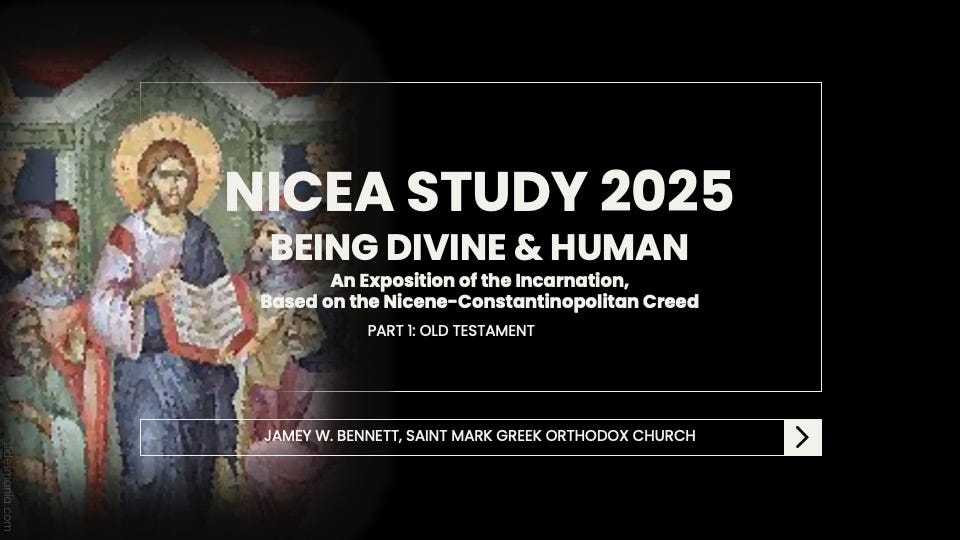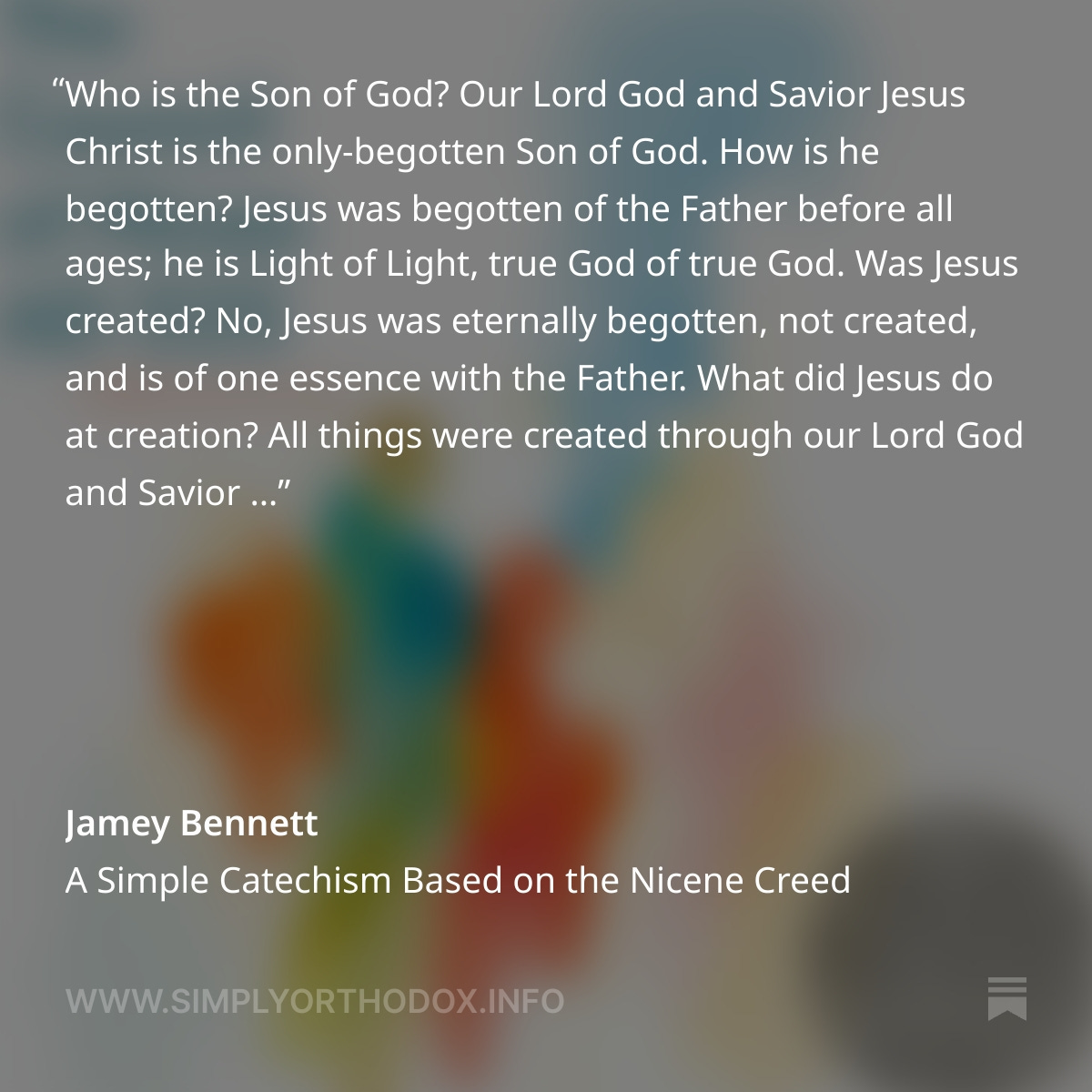Being Divine and Human: Jesus in the Old Testament
Part 1: The Old Testament—An Exposition of the Incarnation, Based on the Nicene-Constantinopolitan Creed
The following is based on a class presentation at Saint Mark Greek Orthodox Church in Boca Raton, Florida. The article has been adapted from an in-person class—the video is included below, along with a PDF download of the slideshow. This is the third part of a five part series on the Creed, you can also view the first article or second article in the series. We are sharing the material in the order it was presented locally at our parish.
Introduction
The Nicene-Constantinopolitan Creed stands as the definitive expression of the basic beliefs of the Orthodox Christian faith—no mere historical artifact, Nicea is a theological cornerstone guiding the Church for nearly seventeen centuries.
But why does an “unchanging church” have to write a Creed? The Creed does not alter the eternal truth delivered by God but serves as a Spirit-guided clarification, forged in the fires of debate and heresy. The Creed emerged as a crucial response to those who, as Paul warned in 2 Timothy 4:3-4, would reject sound doctrine, turning from truth to myths. To grasp the Creed is to see the Church’s steadfast resolve to uphold the apostolic faith and proclaim the one true Lord and King of the cosmos.
“For the time is coming when people will not endure sound teaching, but having itching ears they will accumulate for themselves teachers to suit their own passions, and will turn away from listening to the truth and wander off into myths.” - Saint Paul
The Councils and the Challenge of Heresy
The Creed is the product of two pivotal ecumenical councils: the First Council of Nicaea in AD 325 and the First Council of Constantinople in AD 381. These gatherings of bishops from across the Christian world were not convened to invent new doctrines, but to defend the faith against teachings that distorted the nature of God. As Archbishop Dmitri of Dallas notes, the Creed is as detailed as it is “because almost every element of those teachings was questioned or distorted by someone.”
The most significant of these early challenges was Arianism, which taught that the Son of God was a created being, subordinate to the Father. This directly contradicted the apostolic understanding of Christ's divinity. To counter this, the Council of Nicaea introduced the crucial term homoousios, meaning “of the same essence” or “consubstantial.” This affirmed that the Son shares the exact divine nature of the Father, being “true God of true God.”
As Fr. Stephen Kostoff explains, “What God is by nature, so is the Son of the identical nature. Yet, the Father and the Son are distinct as divine Persons.”
This article is a summary of a larger class presentation. Download a PDF of the slideshow and watch the hour long teaching video below:
The Trinity: Fountainhead of Divinity and Eternal Generation
The Creed’s opening lines establish the foundational doctrine of the Holy Trinity. God the Father is understood as the “fountainhead of divinity” (πηγὴ τῆς θεότητος), the eternal source and origin of the Son and the Holy Spirit. This relationship is not hierarchical, but relational.
The begetting of the Son is not an event in time but an eternal reality—“before all ages.” The term beget signifies that the Son shares the Father's very nature, just as a human child shares the nature of its father. The Church teaches that this eternal generation also means the Son is co-eternal and co-equal with the Father. There was never a time when the Son was not. This stands in stark contrast to heresies like Arianism or modern-day groups such as Jehovah's Witnesses and Mormons, who posit a created or subordinate Christ.1
As St. John of Damascus taught, “the begetting of the Son and the procession of the Holy Ghost from the Father are simultaneous.” They happen without beginning or end. Here’s more from the Damascene:
“To all this holy Scripture and all the company of the saints bear witness. But what the substance of God is, or how it is in all things, or how the only-begotten Son, who was God, emptied Himself out and became man from a virgin's blood, being formed by another law that transcended nature, or how He walked dry-shod upon the waters, we neither understand nor can say. And so it is impossible either to say or fully to understand anything about God beyond what has been divinely proclaimed to us, whether told or revealed, by the sacred declarations of the Old and New Testaments.” - Saint John of Damascus
The Pre-Incarnate Christ: The Word and Wisdom of God
Long before His birth in Bethlehem, the Son of God was active in creation and in the history of Israel. The prologue of John’s Gospel says: “In the beginning was the Word, and the Word was with God, and the Word was God. … All things were made through him” (John 1:1, 3). The Church Fathers recognized this divine Word, or Logos, as the Jesus Christ Himself. Colossians 1:16 reinforces this, proclaiming, “For by him all things were created, in heaven and on earth… all things were created through him and for him.”
Furthermore, Christ is identified as the eternal Wisdom of God. When Proverbs 9:1 says, “Wisdom has built her house,” St. Gregory of Nyssa sees this as Wisdom—Christ—enigmatically describing the formation of His own flesh in the Virgin’s body. This is a recurring theme; Christ is not an afterthought in creation but its very point and purpose. St. Nicholas Cabasilas teaches us, “It was not the old Adam who was the model for the new, but the new Adam for the old.”
Theophanies: Christ's Appearances in the Old Testament
The early Church read the Old Testament “Christologically,” identifying numerous divine appearances—or, theophanies—as manifestations of the pre-incarnate Son. The “Angel of the Lord” who appears throughout the Old Testament was understood to be Christ himself. St. Justin Martyr wrote that this biblical figure is at once “Angel and God and Lord and Man.”
Here are a few examples from the Old Testament:
The Hospitality of Abraham (Genesis 18): When three men appear to Abraham at the oaks of Mamre, Abraham addresses them in the singular: “O Lord, if I have found favor in your sight, do not pass by your servant.” St. Ambrose observed, “Abraham saw three and worshiped one.” St. John Chrysostom and other Church Fathers agreed, seeing this as a manifestation of Christ, flanked by two angels. This is seen by the Church as prefiguring the revelation of the mystery of the Trinity.
Moses and the Burning Bush (Exodus 3): The “I AM WHO I AM” who speaks to Moses from the bush is the same one who declares in the New Testament, “before Abraham was, I am” (John 8:58). The first Christian martyr, St. Stephen, enraged the Sanhedrin by recounting this history and identifying this divine actor as the same Jesus they had rejected (Acts 7).
The Rock in the Wilderness (1 Corinthians 10:4): St. Paul explicitly states that the Israelites in the desert “drank from the spiritual Rock that followed them, and the Rock was Christ.”
This interpretive key, what Fr. Bogdan Bucur calls a “christologically re-envisioned Bible,” unlocks the coherence of Scripture, showing a single, continuous narrative of salvation culminating in Christ. (See the free downloadable PDF for fuller presentation of material.)
Prophecies of the Messiah
There are numerous other places where the Old Testament points to Christ through prophecies that the early Church saw as being fulfilled in Jesus.
The Psalms speak of the Anointed King (Psalm 2), the Davidic Heir (Psalm 89/88 LXX), the eternal Priest after the order of Melchizedek (Psalm 110/109 LXX), and, most vividly, the suffering of the Crucified One (Psalm 22/21 LXX).
Isaiah foretells the virgin birth (“the virgin shall conceive and bear a son, and you shall call his name Emmanuel,” Isaiah 7:14), the divine nature of the child (“Wonderful Counselor, Mighty God, Everlasting Father, Prince of Peace,” Isaiah 9:6), and the suffering servant who “was pierced for our transgressions” (Isaiah 53:5).
Daniel explains the appearance of a fourth man in the fiery furnace with an appearance “like a divine son” (Daniel 3) and the vision of the Son of Man coming on the clouds to the Ancient of Days (Daniel 7). Historic Christianity has always seen these texts as talking about Jesus Christ.
The Incarnation: Kenosis and Salvation
The climax of this divine plan is the Incarnation: “Who for us men and for our salvation came down from Heaven, and was incarnate of the Holy Spirit and the Virgin Mary, and became man.” This "coming down" is not a spatial movement, but a condescension. As Archbishop Dmitri of Dallas explains: although Christ as God is everywhere, he was present on earth invisibly; in the Incarnation, He became visible.
This act is described by St. Paul as kenosis, or self-emptying. In Philippians 2:6-7, we read that Christ, “although He existed in the form of God, did not regard equality with God a thing to be grasped, but emptied Himself, taking the form of a bond-servant, and being made in the likeness of men.” This is the ultimate act of love—the Creator entering His creation to redeem it.
The Witness of the Martyrs and the Unveiled Truth
The apostles and early Christians were so convinced of this reality that they were willing to die for it. They proclaimed a crucified Jewish peasant as King, an act that “turned the world upside down” (Acts 17:6) and directly challenged the authority of Caesar. Their martyrdom was not a tragedy but a “crown of honor,” a testament to the life-transforming power of the resurrected Christ.
For them, the resurrection unveiled the true meaning of the Scriptures. As Jesus explained to the disciples on the road to Emmaus, beginning with Moses and all the Prophets, He “interpreted to them in all the Scriptures the things concerning himself” (Luke 24:27). St. Paul writes that for those who do not turn to the Lord, a veil remains over their hearts when they read the Old Testament, “because only through Christ is it taken away” (2 Corinthians 3:14).
Conclusion: The Mystery of Faith
The Nicene Creed is not an ancient artifact. It is a living confession of faith in the Triune God and the saving work of Jesus Christ. It distills the Church’s understanding of the faith in a memorable way, reinforced by 17 centuries of prayer and worship, alongside theological reflection, of God’s nature and His saving acts.
The Creed summons every generation to behold Christ, the eternal Word incarnate, who fulfills all God’s promises, “tramples down death by death,” and offers eternal life to the world. Reciting the Creed unites us with saints and martyrs across history, proclaiming the holy mystery that lies at the heart of our salvation.
We have two more installments in our series on Nicea (in honor of 1700 Years since the Council) in the coming weeks.
Select Bibliography
Behr, John. Becoming Human: Meditations on Christian Anthropology in Word and Image. Crestwood, NY: St Vladimir’s Seminary Press, 2013.
Bucur, Bogdan G. Scripture Re-envisioned: Christophanic Exegesis and the Making of a Christian Bible. Leiden/Boston: Brill, 2019.
Bishop Danilo (Krstic) Hieromonk Amfilohije (Radovic). No Faith is More Beautiful than the Christian Faith. Los Angeles: Sebastian Press, 2015.
Pentiuc, Eugen J. Hearing the Scriptures: Liturgical Exegesis of the Old Testament in Byzantine Orthodox Hymnography. New York: Oxford University Press, 2021.
Pentiuc, Eugen J. Jesus the Messiah in the Hebrew Bible. Mahwah, NJ: Paulist Press, 2006.
Bishop Dmitri (Royster) of Dallas. The Doctrine of Christ: A Layman’s Handbook. Miami: Diocesan Publications, 1984.
Prefer to watch the video on YouTube? Here you go!
Interestingly, subordinationist errors have even crept into modern conservative Presbyterianism—from folks who have elsewhere affirmed Chalcedon inexplicably.





